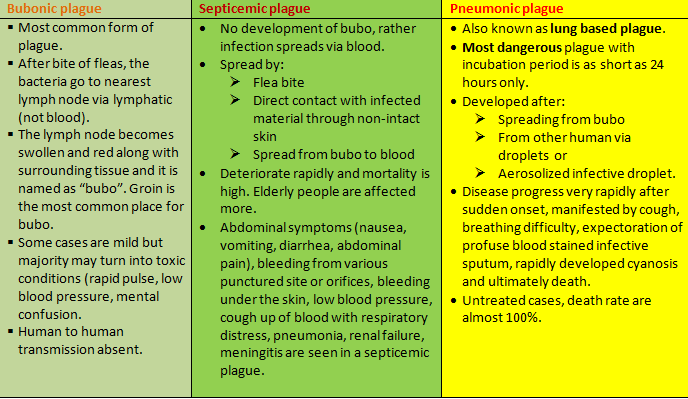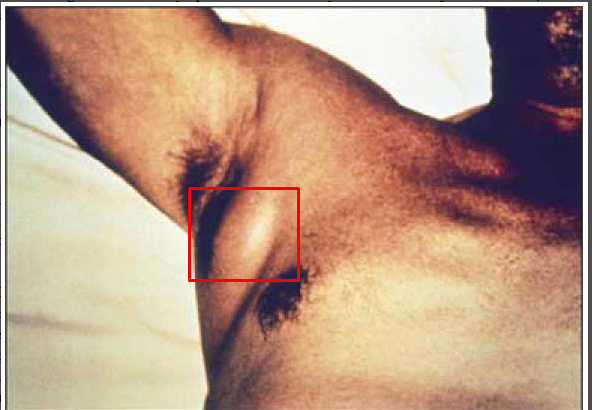Madagascar, an island country in Africa, experienced the last outbreak of plague 1st August 2018 to 22nd Nov 2018. Over centuries, the plague has struck various nations in various timeline either in the form of epidemic or pandemic. Its last attack was in Madagascar. According to world health organization, confirmed death due to the plague was 202, though unofficial death may be higher than announced. In this post we will learn details on the Plague.
What is the plague?
Plague is a highly infectious zoonotic disease caused by a bacterium named Yersinia pestis. Zoonotic disease means it transmits from non-human (animals/mammals) to human (but human to human transmission possible).
- Reservoir or source of infection: Small rodents like rats, mice, squirrels etc
- Transmitted by: Infected fleas feeding on those small rodents who are already harboring Yersinia pestis bacteria
- Mode of transmission: the bite of infected fleas. Direct contact with infected materials (secretion/feces) via cracked or cut skin. Also human to human transmission possible by spreading to infected droplets during coughing /sneezing of the diseased person.
A picture of Oriental rat flea image source
What are the manifestations of plague?
It is said that first sign of the appearance of plague is dead rats. In human, it usually starts with flu-like symptoms,i.e. sudden onset of fever or chill, headache, body ache, weakness, nausea, vomiting. Usually incubation period is 3-6 days but in some case (Pneumonic) it might be as short as 24 hours only. (Incubation period= the interval period between entry of bacteria in human body and development of symptoms). After initial symptoms, the disease may turn into any of these 3 forms.
History of plague:
Plague has a significant remark in human history. For centuries, plague brought disasters and death to human being mainly in Asia, Africa, and Europe. Whenever it attacked a country or regions, most of the people were wiped out. In some instance, the severity was so high that there were no survivals to bury the deceased. Now we know that small rodents are the source of infection but during ancient pandemics, people had no idea what was killing them. From retrospective research, we now know that black rats were most commonly affected rodents and source of infection of the bacteria.
In human history, there are 3 major plague pandemics. In the following picture, we will see short details of those pandemics.
Few recent epidemics:
Before Madagascar, India suffered from the plague in the first half of 20th Century. During Vietnam War, there was an epidemic between the 1960s and 1970s. Plague is endemic in sub-Saharan Africa and Madagascar. Madagascar is last of the epidemic list of plague.
Facts and Statistics of Madagascar Outbreak of plague:
- According to WHO, from 1st August 2018 to 22nd Nov 2018, total plague cases were 2348 (confirmed + probable +suspected).
- Total death was 202 and case fatality rate is 8.6%.
- Death reports came from 55 out of 114 districts of the country.
- Almost 68% of Madagascar was affected and Analamanga Region was the most affected part of the country.
- Out of 2348, 1791 were classified as pneumonic plague, 341 were classified as bubonic plague and one was classified as the septicemic plague. Remaining 215 cases were not classified. A total of 81 health workers had been affected but none of them died.
- During this time, 33 strains of Yersinia pestis had been isolated and fortunately, all were sensitive to antibiotics.
Plague as bioweapon
Over time, the plague has been used as a biological weapon. It is chosen in warfare because of its suitable properties. Those are:
- High mortality rate (pneumonic plague)
- Highly contagious
- Capacity for mass production
- Possibilities of aerosol transmission
- Potential for rapid secondary transmission (person to person)
Below you will find some examples of using plague as a biological weapon:
In 1346, The Tartars first used plague in their favor though it was not a preplanned weaponized plague. They sieged Caffa, a seaport, well-fortified and controlled by Genoese. But unfortunately they started suffering from plague and their soldiers started dying. However, they turned their misery into an opportunity. They hurl their deceased cadaver into the city. An outbreak of plague took place and compelled the Genoese force to retreat. This procedure was applied to various success rates over next centuries.
Unit 731 of the Japanese Army dropped plague-infected fleas over some populated areas in China and Manchuria during Second World War.
During World War II, both USA and the former Soviet Union tried to turn plague into a biological weapon by releasing it in aerosolized form. Later the scientists of Soviet Union were successful in producing large quantities of plague organism and were able to place those into weapons.
Like anthrax, nowadays it raises concern as it might be used by the terrorist group as a weapon.
What would happen if one of the world superpowers drops a plague bomb?
WHO published a report in 1970 which showed the possible result of plague as a bioweapon in a populated area. Suppose, someone drops 50 kg of Yersinia pestis in aerosolized bomb over a city with a population of 5 million. In worst case scenario, approximately 150k person would be infected with the pneumonic plague and 36k of them is expected to die.
Treatment and prevention of plague:
Fortunately, plague is a bacterial illness and that bacterium is susceptible to antibiotics treatment. So, early diagnosis and effective treatment are sufficient to save lives. Among antibiotics, Streptomycin(1 g two times daily) and/or gentamicin(1 mg/kg body weight 3 times per day) are the first choice. Other alternatives are tetracycline (500mg 4 times per day) and chloramphenicol (12.5 mg/kg body weight 4 times per day). Ciprofloxacin and levofloxacin may be an effective but less clinical experience.
A picture of "plague doctor"source
Rats and fleas must be controlled in the endemic area and people should avoid handling and skin wild animals.
If someone comes in contact with plague, she/he must be isolated. The nurses or physicians must wear gowns, masks, and gloves.
Any exposed person should receive post-exposure prophylactic antibiotics (doxycycline 100mg 2 times daily or ciprofloxacin 500mg 2 times daily for 7 days.
What is Yersinia pestis?
- It is a bacterium.
- It is a Gram-negative Enterobacteriaceae.
- It is coccobacillus (some of them are round in shape, while others are rod-like)
- It is an intracellular bacteria and must remain in blood to survive.
- It can cause diseases in rodent, insects, and human
- Carriers of this bacterium are: Oriental rat flea, Xenopsylla cheopis, and infected rodents
- It encodes two antigenic molecules and for that, it required at least 37-degree centigrade temperature. It explains why it chooses mammals.
Reference:
- Those pictures where sources are not mentioned either made by myself or from pixabay/wikimedia.
- https://www.ncbi.nlm.nih.gov/pmc/articles/PMC1200711/
- http://www.who.int/csr/don/27-november-2017-plague-madagascar/en/
- https://www.cdc.gov/plague/history/index.html
- http://web.uconn.edu/mcbstaff/graf/Student%20presentations/Y.%20pestis/Yersinia%20pestis.html
You will find this article on the steem blockchain. Read here









0 Comments